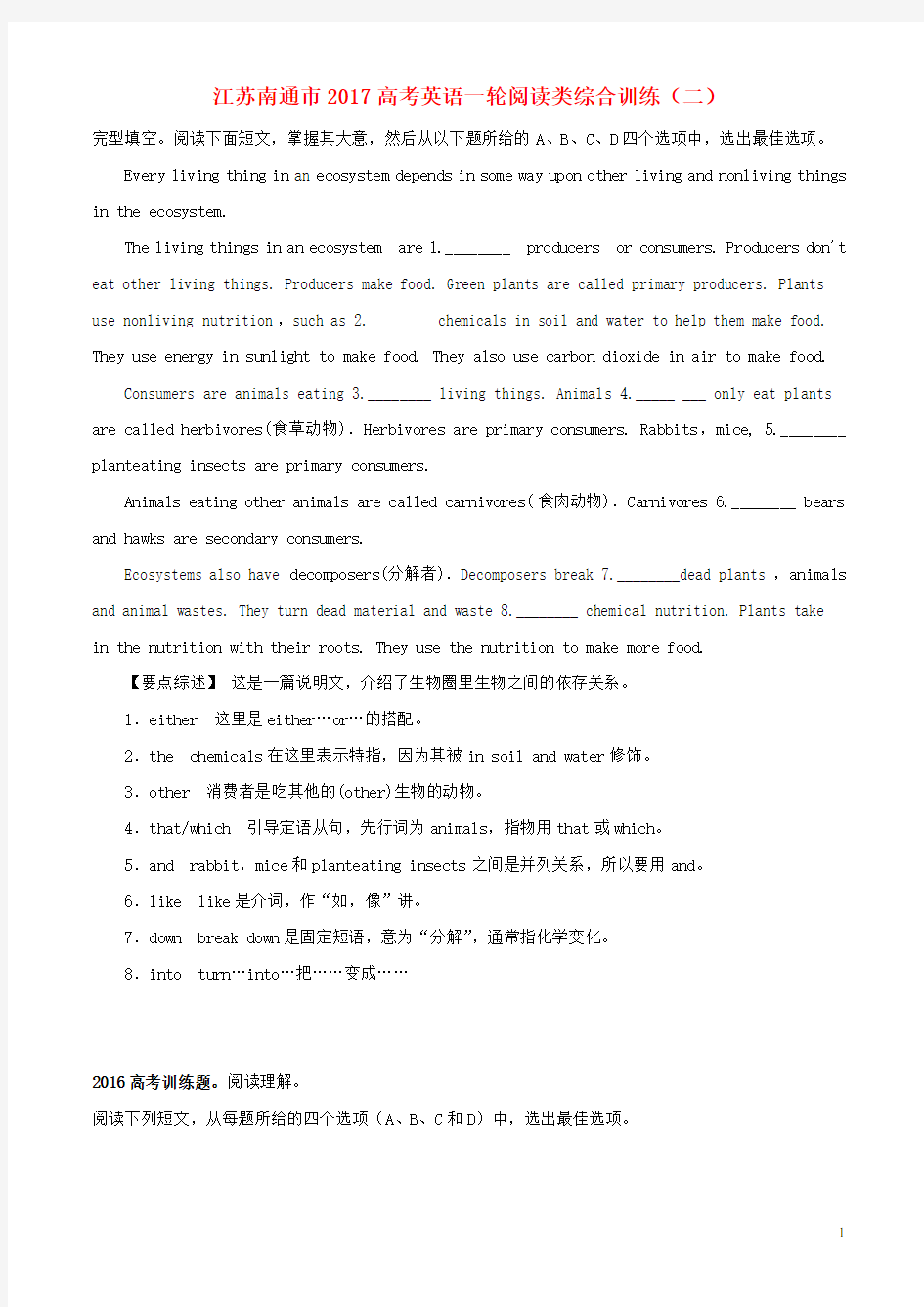江苏省南通市高考英语一轮复习 阅读类综合训练(二)

- 1、下载文档前请自行甄别文档内容的完整性,平台不提供额外的编辑、内容补充、找答案等附加服务。
- 2、"仅部分预览"的文档,不可在线预览部分如存在完整性等问题,可反馈申请退款(可完整预览的文档不适用该条件!)。
- 3、如文档侵犯您的权益,请联系客服反馈,我们会尽快为您处理(人工客服工作时间:9:00-18:30)。
江苏南通市2017高考英语一轮阅读类综合训练(二)
完型填空。阅读下面短文,掌握其大意,然后从以下题所给的A、B、C、D四个选项中,选出最佳选项。
Every living thing in an ecosystem depends in some way upon other living and nonliving things in the ecosystem.
The living things in an ecosystem are 1.________ producers or consumers. Producers don't eat other living things. Producers make food. Green plants are called primary producers. Plants use nonliving nutrition,such as 2.________ chemicals in soil and water to help them make food. They use energy in sunlight to make food. They also use carbon dioxide in air to make food.
Consumers are animals eating 3.________ living things. Animals 4._____ ___ only eat plants are called herbivores(食草动物).Herbivores are primary consumers. Rabbits,mice, 5.________ planteating insects are primary consumers.
Animals eating other animals are called carnivores(食肉动物).Carnivores 6.________ bears and hawks are secondary consumers.
Ecosystems also have decomposers(分解者).Decomposers break 7.________dead plants,animals and animal wastes. They turn dead material and waste 8.________ chemical nutrition. Plants take in the nutrition with their roots. They use the nutrition to make more food.
【要点综述】这是一篇说明文,介绍了生物圈里生物之间的依存关系。
1.either 这里是either…or…的搭配。
2.the chemicals在这里表示特指,因为其被in soil and water修饰。
3.other 消费者是吃其他的(other)生物的动物。
4.that/which 引导定语从句,先行词为animals,指物用that或which。
5.and rabbit,mice和planteating insects之间是并列关系,所以要用and。
6.like like是介词,作“如,像”讲。
7.down break down是固定短语,意为“分解”,通常指化学变化。
8.into turn…into…把……变成……
2016高考训练题。阅读理解。
阅读下列短文,从每题所给的四个选项(A、B、C和D)中,选出最佳选项。
It's 10:30 pm, and 11-year-old Brandon Blanco is sound asleep at home. Suddenly, a loud noise wakes him up. Naturally, Brandon reaches for his cell phone. The message becomes clear: "R U awake?" Brandon' s use of technology doesn' t stop there. He also has a computer, a TV and three video-game consoles (控制台 ) in his room. With so many choices, it' s no surprise that when he isn' t at school, he spends nearly every waking minute using one or more of these devices Brandon is hardly alone. According to a recent study by the Kaiser Family Foundation, kids aged 8 to18 are spending more time than ever before using electronic devices. How much time? More than seven and a half hours a day on average, the study found.
The jump is the result of a huge explosion in mobile devices, says Victoria Rideout, the lead author of the study. Today, nearly seven out of ten kids have cell phones. Just five years ago, it was four out of ten.
Often, kids multitask, or use more than one device at a time. " If you’ve got a chance to do something on your computer and take a phone call and have the TV on in the background, why not?" media expert Cheryl Olson says.
Most experts agree technology has much to offer kids. But some worry the kids could be missing out on other activities like playing outside or hanging out with friends. " It' s a matter of balance," says Olson." You’ve got to work on it. "
Multitasking while doing homework is another concern. Some kids listen to music, watch TV or use the phone while doing their homework. "It' s important to make sure that you can stop and concentrate on one thing deeply, " says Rideout.
With new and exciting devices hitting stores every year, keeping technology use in check is more important than ever. " Kids should try," adds Rideout. " But parents might have to step in sometimes. "
1. Why do children spend more time in using electronic devices?
A. Because electronic devices are more exciting than before.
B. Because more electronic devices are available to them.
C. Because they have less other activities.
D. Because they have less homework to do.
2. It is known from the passage that ____.
A. Brandon Blanco feels very annoyed about his late-night text
B. the teenagers using mobile devices have increased by 30% in the past five years
